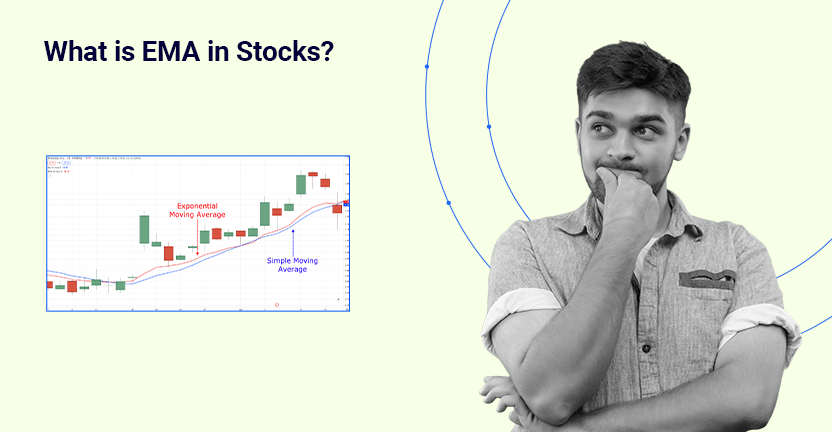The exponential Moving Average (EMA) is a popular technical indicator used in stock trading to analyse price trends and identify potential buy and sell signals. Unlike the Simple Moving Average (SMA), EMA gives more weight to recent price movements, making it more responsive to market changes. Traders and investors use EMA to spot trends, reversals, and support and resistance levels.
This guide will explain what EMA is in the stock market, how it differs from other moving averages, its calculation method, and strategies for effectively using EMA in trading.
What is EMA in the Stock Market?
Exponential Moving Average (EMA) is a technical indicator used in stock trading to track price trends over a specified period. Unlike the Simple Moving Average (SMA), which gives equal weight to all data points, EMA places more emphasis on recent prices. This makes it more responsive to market changes and helps traders identify trends, reversals, and potential buy or sell signals.
EMA smooths out price fluctuations, reducing noise and providing a clearer view of the underlying trend. It is commonly used to analyse short-term and long-term price movements, helping traders make informed decisions.
For example, a 20-day EMA calculates the average price over the last 20 days but gives more weight to the most recent days. If the stock price is consistently above the 20-day EMA, it indicates an uptrend, while prices below the EMA suggest a downtrend.
How Does EMA Differ from Simple Moving Average (SMA)?
Although both Exponential Moving Average (EMA) and Simple Moving Average (SMA) are used to analyse stock price trends, they differ in their calculation methods and responsiveness to price changes. Here’s how they compare:
1. Calculation Method
- SMA calculates the average price over a specified period by giving equal weight to all data points. For example, a 10-day SMA adds the closing prices of the last 10 days and divides the sum by 10.
- EMA, on the other hand, gives more weight to recent prices, making it more sensitive to new information. It uses a smoothing factor to adjust the average, ensuring that the latest prices have a greater impact on the calculation.
2. Responsiveness to Price Changes
- EMA responds more quickly to recent price movements compared to SMA, which makes it better suited for short-term trading strategies.
- SMA is slower to react to price changes due to its equal weighting method, making it more suitable for long-term trend analysis.
3. Signal Accuracy and Noise Reduction
- EMA provides more accurate signals during volatile markets as it adjusts faster to price changes. However, this sensitivity also makes it prone to false signals in choppy markets.
- SMA smooths out price fluctuations more effectively, reducing noise but potentially lagging behind actual price trends.
4. Use in Trading Strategies
- Traders often use EMA for short-term trading strategies like day trading and swing trading, as it quickly adapts to market changes.
- SMA is commonly used for identifying long-term support and resistance levels and analysing overall market trends.
Both EMA and SMA are valuable tools in technical analysis, but their effectiveness depends on the trader’s strategy and time horizon.
How is EMA Calculated for Stock Price Trends?
Calculating the Exponential Moving Average (EMA) involves a systematic approach that places more weight on recent prices, making it more responsive to market changes. Here’s how it’s done:
1. Calculate the Simple Moving Average (SMA)
- The calculation begins with the Simple Moving Average (SMA) for the initial period.
- For example, to calculate a 10-day EMA, add the closing prices of the last 10 days and divide by 10.
- Formula:
2. Determine the Smoothing Factor (Multiplier)
- The smoothing factor gives more weight to recent prices and is calculated as:
- For a 10-day EMA, the multiplier is:
3. Calculate the EMA
- EMA is calculated using the following formula:
EMA=(Closing Price−Previous EMA)×Multiplier+Previous EMA
- The previous EMA is used to ensure continuity in the calculation.
- This formula applies the smoothing factor to the most recent price, giving it more weight compared to older prices.
Example Calculation
Assume the previous day’s EMA was 50, and today’s closing price is 52. For a 10-day EMA:
- Multiplier = 0.1818
- EMA = (52 – 50) × 0.1818 + 50 = 50.36
4. Continuation of the Calculation
- The newly calculated EMA becomes the “Previous EMA” for the next day’s calculation.
- This continuous calculation creates a smooth moving average line that adjusts to recent price movements.
The EMA calculation method makes it more sensitive to price changes compared to the Simple Moving Average (SMA), helping traders spot trends and reversals more effectively.
Common Time Frames Used for EMA in Trading
Traders use different time frames for Exponential Moving Averages (EMA) depending on their trading strategies and investment goals. Each time frame serves a specific purpose and helps identify trends, support, resistance, and entry or exit points. Here are the most commonly used EMAs:
1. Short-Term EMAs (5 to 20 Days)
- Purpose: Ideal for day trading and swing trading, short-term EMAs capture quick price movements.
- Popular Time Frames: 9-day and 20-day EMAs are commonly used to identify short-term trends and momentum.
- Application: Traders look for crossovers (e.g., 9-day EMA crossing above the 20-day EMA) as buy signals, while crossovers below are seen as sell signals.
2. Medium-Term EMAs (20 to 50 Days)
- Purpose: Useful for identifying intermediate trends and tracking market sentiment over several weeks.
- Popular Time Frames: 50-day EMA is widely used to analyse medium-term trends and support or resistance levels.
- Application: A stock trading above its 50-day EMA is generally considered in an uptrend, while trading below indicates a downtrend.
3. Long-Term EMAs (100 to 200 Days)
- Purpose: Used by long-term investors to identify major trends and support or resistance zones.
- Popular Time Frames: 100-day and 200-day EMAs provide a broad view of the stock’s overall trend and stability.
- Application: Long-term investors look for the “Golden Cross” (50-day EMA crossing above the 200-day EMA) as a bullish signal, and the “Death Cross” (50-day EMA crossing below the 200-day EMA) as a bearish signal.
4. Multiple Time Frame Analysis
- Traders often use multiple EMAs on the same chart to confirm trends and avoid false signals.
- For example, combining 20-day, 50-day, and 200-day EMAs provides a comprehensive view of short, medium, and long-term trends.
Choosing the right EMA time frame depends on the trader’s strategy, risk tolerance, and investment horizon. Short-term EMAs are more responsive but volatile, while long-term EMAs provide stability but may lag behind market movements.
Using EMA to Identify Buy and Sell Signals
Exponential Moving Average (EMA) is widely used by traders to identify potential buy and sell signals. By analysing the crossover patterns and the stock’s position relative to the EMA line, traders can make informed entry and exit decisions. Here’s how it works:
1. EMA Crossover Strategy
- Bullish Signal (Golden Cross): A buy signal occurs when a shorter-term EMA (e.g., 20-day) crosses above a longer-term EMA (e.g., 50-day). This indicates upward momentum and the beginning of an uptrend.
- Bearish Signal (Death Cross): A sell signal is triggered when the shorter-term EMA crosses below the longer-term EMA, indicating downward momentum and a potential downtrend.
Example:
- If the 20-day EMA crosses above the 50-day EMA, traders consider it a buying opportunity, anticipating a bullish trend.
- Conversely, if the 20-day EMA crosses below the 50-day EMA, traders may sell or short the stock, expecting a bearish trend.
2. Price and EMA Interaction
- Buy Signal: When the stock price moves above the EMA, it suggests bullish momentum, indicating a buying opportunity.
- Sell Signal: If the price falls below the EMA, it signals bearish momentum, suggesting a potential exit or short-selling opportunity.
3. Support and Resistance Levels
- EMAs often act as dynamic support or resistance levels.
- In an uptrend, the stock price tends to bounce off the rising EMA line, acting as support.
- In a downtrend, the falling EMA line acts as resistance, preventing the price from moving higher.
4. Trend Confirmation and Filtering False Signals
- Traders use multiple EMAs, such as the 20-day, 50-day, and 200-day, to confirm trends and avoid false signals.
- If all EMAs are aligned (e.g., 20-day above 50-day, and 50-day above 200-day), it confirms a strong uptrend. Conversely, if the order is reversed, it confirms a downtrend.
5. Combining EMA with Other Indicators
- To enhance accuracy, traders combine EMA signals with other technical indicators like the Relative Strength Index (RSI) or Moving Average Convergence Divergence (MACD).
- For example, a bullish EMA crossover confirmed by RSI moving above 50 provides a stronger buy signal.
Using EMA for buy and sell signals requires practice, discipline, and a strategic approach. Traders should back-test their strategies and use risk management techniques to minimise losses.
Advantages of Using EMA Over Other Moving Averages
Exponential Moving Average (EMA) offers several advantages compared to other moving averages, such as the Simple Moving Average (SMA) and Weighted Moving Average (WMA). Its unique calculation method makes it a preferred choice for traders seeking accurate trend analysis and timely signals. Here’s why:
1. Greater Sensitivity to Recent Price Changes
- EMA places more weight on the most recent prices, making it more responsive to market changes compared to SMA, which gives equal weight to all data points.
- This sensitivity helps traders identify trend reversals and momentum shifts earlier than SMA, enabling timely buy or sell decisions.
2. Accurate and Reliable Signals
- By prioritising recent price movements, EMA provides more accurate signals during volatile market conditions.
- It reduces lag compared to SMA, helping traders react faster to price changes and minimise losses.
3. Better Reflection of Market Sentiment
- EMA captures the latest market sentiment more effectively, reflecting the impact of recent news, events, and economic data.
- This dynamic adjustment makes it a valuable tool for short-term trading strategies like day trading and swing trading.
4. Enhanced Trend Identification and Confirmation
- EMA smooths out price fluctuations while maintaining sensitivity to new data, making it easier to spot trends and reversals.
- Multiple EMAs, such as 20-day, 50-day, and 200-day, can be used together to confirm trends and avoid false signals.
5. Effective Support and Resistance Levels
- EMA lines act as dynamic support and resistance levels, guiding traders in setting stop-loss and take-profit targets.
- In uptrends, prices often bounce off rising EMAs, acting as support, while in downtrends, falling EMAs act as resistance.
6. Versatility in Different Market Conditions
- EMA adapts well to various market conditions, including trending, sideways, and volatile markets.
- It is effective for both short-term and long-term trading strategies, offering flexibility for different investment goals.
7. Compatibility with Other Technical Indicators
- EMA works well with other technical indicators like the Relative Strength Index (RSI), Moving Average Convergence Divergence (MACD), and Bollinger Bands.
- Combining EMA with these indicators enhances trading accuracy and provides more robust signals.
Due to its responsiveness, accuracy, and adaptability, EMA is a preferred moving average for traders looking to gain a competitive edge in the stock market.
How Does EMA Help in Spotting Market Trends and Reversals?
Exponential Moving Average (EMA) is a powerful tool for identifying market trends and reversals. By smoothing out price fluctuations and giving more weight to recent prices, EMA provides traders with valuable insights into market momentum and potential turning points. Here’s how:
1. Identifying Trend Direction
- When the stock price consistently stays above the EMA line, it indicates an uptrend, suggesting buying opportunities.
- Conversely, when the price remains below the EMA line, it signifies a downtrend, indicating selling or short-selling opportunities.
2. Spotting Trend Reversals with Crossover Signals
- Bullish Reversal: A trend reversal from downtrend to uptrend is indicated when a shorter-term EMA (e.g., 20-day) crosses above a longer-term EMA (e.g., 50-day). This crossover is known as a “Golden Cross” and signals a potential buying opportunity.
- Bearish Reversal: A reversal from uptrend to downtrend is identified when the shorter-term EMA crosses below the longer-term EMA. This is known as a “Death Cross” and signals a potential selling opportunity.
3. Confirming Market Momentum
- A widening gap between the shorter-term and longer-term EMA lines indicates strong momentum in the direction of the trend.
- Conversely, when the EMA lines converge, it suggests weakening momentum and a possible trend reversal.
4. Support and Resistance Levels
- EMAs act as dynamic support and resistance levels, guiding traders in setting stop-loss and take-profit targets.
- In an uptrend, prices often find support at the rising EMA line, indicating potential buying zones.
- In a downtrend, the falling EMA line acts as resistance, signalling potential selling zones.
5. Filtering False Signals and Market Noise
- By smoothing out price fluctuations, EMA reduces market noise, helping traders distinguish between temporary pullbacks and actual trend reversals.
- Traders use multiple EMAs (e.g., 20-day, 50-day, and 200-day) to filter false signals and confirm trend strength.
6. Combining EMA with Other Technical Indicators
- EMA is often combined with other technical indicators like the Relative Strength Index (RSI), Moving Average Convergence Divergence (MACD), and Volume.
- For example, a bullish EMA crossover confirmed by an RSI reading above 50 strengthens the buy signal, while a bearish crossover with RSI below 50 confirms the sell signal.
7. Adapting to Different Market Conditions
- EMA is effective in trending markets for identifying trend direction and reversals.
- In volatile or sideways markets, traders use shorter-term EMAs to capture quick price movements and avoid false breakouts.
EMA provides a clear and responsive way to spot market trends and reversals, helping traders make informed trading decisions. It is a versatile tool suitable for both short-term and long-term trading strategies.
EMA: A Powerful Tool for Trend Analysis and Trading
Exponential Moving Average (EMA) is an essential technical indicator that helps traders identify trends, reversals, and market momentum. Its responsiveness to recent price changes makes it a valuable tool for spotting buying and selling opportunities. By using different time frames and combining EMA with other indicators, traders can develop effective trading strategies tailored to their investment goals.
Understanding how EMA works and its application in technical analysis allows traders to navigate market volatility and make informed decisions. Whether you are a short-term trader or a long-term investor, mastering EMA can enhance your trading approach and improve your success rate.
Streetgains provides research-driven insights and educational resources to help investors understand technical indicators like EMA and incorporate them into their trading strategies.
Disclaimer:
The content in this blog is intended for informational purposes only and does not constitute investment advice, stock recommendations, or trade calls by Streetgains. The securities and examples mentioned are purely for illustration and are not recommendatory.
Investments in the securities market are subject to market risks. Please read all related documents carefully before investing.
What is EMA in Stocks? Exponential Moving Average Explained FAQs:
Beginners can start by using shorter-term EMAs (e.g., 9-day or 20-day) to identify quick momentum shifts and longer-term EMAs (e.g., 50-day or 200-day) for overall trend direction. It’s recommended to combine EMAs with other indicators like RSI or MACD for confirmation and to reduce false signals.
One common mistake is relying solely on EMA crossovers for buy and sell signals, which can lead to false trades during choppy markets. Traders also tend to ignore market context, such as news events or broader market trends, which influence EMA movements. Using multiple time frames and combining EMA with other tools helps avoid these errors.
Yes, EMA is versatile and can be applied to various trading strategies, including day trading, swing trading, and long-term investing. However, the choice of time frames matters: shorter EMAs suit intraday trading, while longer EMAs are better for long-term trend analysis.
Professional traders often combine EMA with indicators like RSI to measure momentum, MACD to confirm trend changes, and Bollinger Bands to identify volatility and potential breakouts. For example, a bullish EMA crossover confirmed by RSI above 50 provides a stronger buy signal.
EMA is sensitive to recent price changes, making it effective during volatile markets as it reacts quickly to price movements. However, this sensitivity also makes it prone to false signals in highly volatile conditions. To mitigate this, traders use longer-term EMAs for stability or combine them with volatility indicators like ATR (Average True Range).
EMA performs better than SMA in trending markets due to its responsiveness to price changes. However, in sideways or choppy markets, SMA is more effective in reducing noise. Traders often switch between EMAs and SMAs based on market conditions or use a combination for comprehensive analysis.
Setting the right time frame depends on trading style and goals. Day traders use shorter EMAs (e.g., 9-day or 20-day) for quick momentum shifts, while swing traders prefer medium-term EMAs (e.g., 50-day). Long-term investors rely on 100-day or 200-day EMAs for broader trend analysis. Testing different time frames is essential to find the most effective combination.
Streetgains provides research-driven insights, technical analysis tools, and educational resources to help traders understand and apply EMA strategies effectively. By combining EMA analysis with market trends and sentiment data, Streetgains empowers investors to make informed trading decisions.
FAQs:
-
1. How to earn money daily from trading?
Earning money daily from trading involves strategies like day trading, where traders capitalise on small price movements within the same day. Success requires real-time market analysis, quick decision-making, and risk management.
-
2. How to earn money from equity trading?
To earn money from equity trading, you need to buy stocks at a lower price and sell them at a higher price. Success depends on researching companies, analysing stock trends, and using technical or fundamental analysis.
-
3. How to earn money from share trading in India?
In India, share trading offers profit potential through buying and selling stocks on exchanges like the NSE and BSE. To maximise returns, traders should use market research, tools like technical analysis, and risk management strategies.
-
4. How to make money from share trading in India?
Making money from share trading involves selecting the right stocks, timing the market, and implementing trading strategies like swing trading or day trading while staying informed about market trends.
-
5. How to transfer money from a trading account to a bank account?
To transfer money from your trading account to your bank, log into your trading platform, navigate to the funds section, and initiate a withdrawal request. The money will typically be credited to your linked bank account in 1 to 3 days.
-
6. How to withdraw money from a trading account?
You can withdraw funds by logging into your trading account, selecting the withdrawal option, and selecting the amount to transfer to your bank account. Ensure your bank account is linked and follow any steps your broker requires.
Subscribe to our Credits-Based Research System:
Pay only for successful research calls!












